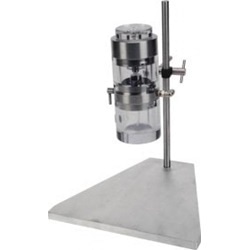Sponsored Content by Glas-ColNov 23 2018
One of a number of techniques for obtaining biological molecules of interest from inside a cell is ‘cell disruption.’ The introduction of the French press in the 1940s represents the oldest method for achieving this.

The French press was a novel laboratory instrument which used a hydraulic piston in order to induce high pressure within a sample cylinder. Cells were forced through a narrow aperture by these pressures. The plasma membranes and cell walls were consequently disrupted, supporting the isolation of proteins, nuclei, and other microorganisms.
Although this method was incredibly advanced for its time, it is significantly limited in relation to laboratory instruments of the 21st century. The isolation of specific microscopic analytes by breaking living cells apart remains a key process in a variety of life science and biochemical applications.
Cutting-edge laboratory instruments – which were able to operate based on entirely new fragmentation principles – were required in order to perform this isolation method at scale, as well as to new levels of both reliability and accuracy. In order to reach new levels of control for cell nebulization, the BioNeb® Cell Disruption System was engineered to meet these exacting standards.
Outlining the Principles of Nebulization
While in the French press, physical induction of pressure was used to break cell structures apart, the nebulization principle is the basis of BioNeb® laboratory instruments.
The stringent regulation of gas pressures between 10 and 250 psi is used by an analytical nebulizer, in order to reduce a liquid medium to an extremely fine mist. Cells which are suspended in the liquid medium are subsequently distributed forcefully into the secondary droplet. This creates a microcapillary channel which has a laminar flow which exhibits enough shear force to break a cell structure apart.
Three primary factors are required for shearing forces: liquid medium viscosity; gas pressures; and gas compositions. By the manipulation of these parameters, it is possible to finely tune the shearing forces. As an example, a higher percentage of cells breaking at a lower pressure operation generally results from increased medium viscosity.
Consequently, BioNeb® laboratory instruments are capable of nebulization shearing of significantly varied values. In only three passes, cells can be either totally disrupted or gently opened. In just a single pass, it is also possible to achieve a disruption rate of numerous cell types as high as 90%. This process is extremely efficient, with negative heat generation and flow rates of 30 ml/minute.
BioNeb Laboratory Instruments from Glas-Col
Including biochemistry and life sciences, comprehensive solutions for cell disruption techniques in a variety of applications are provided by Glas-Col. They offer three distinct BioNeb® laboratory instruments, equipped with a proprietary regulator for double-stage control of the gas pressure parameters and reservoir chambers of 5 – 30 ml sample volumes.
About Glas-Col
Glas-Col is the world's leading manufacturer of laboratory products and industrial heating and mixing technology. The combination of modern facilities, and highly trained personnel, keep Glas-Col on the leading edge of technology for pharmaceutical, biotechnology, semiconductor, industrial, and the research & development industry.
Ongoing product development, using state-of-the-art manufacturing concepts and materials, is one of the key ingredients to Glas-Col's continued success in meeting our client's application requirements.
With over 70 years of experience Glas-Col is also capable of meeting the needs of researchers and scientists. Our laboratory equipment and industrial products are backed by our excellent service, support and technical know how. Glas-Col is an ISO certified company and has maintained this certification for fourteen straight years. Our goal is to provide quality laboratory equipment, safety accessories and industrial products which will provide you, the customer, repeatable, reliable, results.
Sponsored Content Policy: News-Medical.net publishes articles and related content that may be derived from sources where we have existing commercial relationships, provided such content adds value to the core editorial ethos of News-Medical.Net which is to educate and inform site visitors interested in medical research, science, medical devices and treatments.